|
Corn Earworm, European Corn Borer, Fall Armyworm, Or Western Bean Cutworm: Which One Is Causing The Injury I’m Finding On My Corn Ears?
KELLY ESTES
CHAMPAIGN, ILL.
Several questions about injury on corn ears has made it way to my desk the past week. Damaged ear tips, missing kernels, and fungal pathogens are all being reported. Several insect pests in Illinois could be the culprit. Corn earworm, fall armyworm, European corn borer, and western bean cutworm are pests of Illinois cornfields. Their larvae all feed on the ears of corn plants.
So how does one determine the cause of ear damage this late in the season? The answer is simple: You really can’t. At this time in the season, it is rare to find any larvae still feeding on corn ears. Without larvae, you can’t be positive if injury was caused by earworms, corn borers, fall armyworms, or bean cutworms, as they cause very similar injury. Let’s look at each insect individually.
Corn earworm. Two generations of corn earworm infest Illinois cornfields each year. Because earworms generally do not overwinter in Illinois, summer populations arise primarily from immigration of moths from southern states in late spring and early summer. Infestations of earworm larvae can cause injury to corn plants, including slight defoliation of leaves, damage to the tassel, and consumption of silks and kernels. The second corn earworm generation usually occurs during pollination. Larvae enter the ear primarily through the silk channel, unlike European corn borer and fall armyworm, which enter through the husks or cob. As silks dry, corn earworm begin feeding on kernels. Larvae feed at the tip and along the sides of the ear near the tip, continuing to feed until they mature. At that time the larvae drop to the ground to pupate. When leaving the ear, corn earworm may drop from the ear tip or create exit holes by chewing through the husk. These exit holes can be mistaken for entrance holes caused by other larvae.
European corn borer. Two to three generations of European corn borer occur in Illinois each year. Injury to corn ears is caused by the second and third generations. Loss of grain to larvae’s direct feeding on kernels has not recently been an issue in field corn, but in sweet corn and seed corn, losses can be significant. We’ve also received reports of corn borer feeding in non-GMO corn. Larvae feed on pollen and silks before entering the ear. Entry to the ear is also gained by tunneling through the shank and cob. Ear feeding by corn borer larvae is not focused on any one area. Injury can be found at both ends and along all sides of the ear. Larvae feed until mature; they overwinter as fifth-larval instars in stalks and plant debris.
Fall armyworm. Like the corn earworm, fall armyworm moths migrate north into Illinois each year. Fall armyworms are a concern for cornfields from mid- to late summer. They cause serious leaf-feeding damage and feed directly on corn ears. Late-planted or later-maturing hybrids are more susceptible to fall armyworm injury. Most common is pretasseled corn. Larvae consume large amounts of leaf tissue, but as corn plants develop, larvae move to the ear. Unlike the corn earworm, the fall armyworm feeds by burrowing through the husk on the side of the ear. Larvae also enter at the base of the ear, feeding along the sides and even tunneling into the cob. They usually emerge at the base of the ear, leaving round holes in the husks.
Western bean cutworm. A mid- to late-summer pest of corn, western bean cutworm moths begin to emerge in early July. Though some leaf feeding occurs, larvae feed primarily on silks, tassels, and developing kernels. Larvae of the western bean cutworm are not cannibalistic, and several larvae may infest one ear. Entry to ears is gained through silk channels or by chewing through husks, injuring the tip, base, and sides of the ear. Larvae feed on kernels until about mid-September, when they exit through husks. Reports of western bean cutworm injury have been very sporadic the past couple of years.
Any one or combination of the aforementioned insects could be the cause of the injury being seen in cornfields. As much as we would like to be able to pinpoint the direct cause of injury, that is often impossible this late in the season. Summer scouting is the key to determining the potential insect culprits. ∆
KELLY ESTES: Agricultural Pest Survey Coordinator, University of Illinois
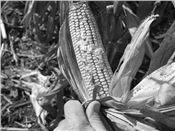
Insect injury to corn ear
Photo courtesy of Duane Frederking
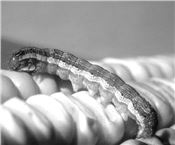
Corn earworm larvae.
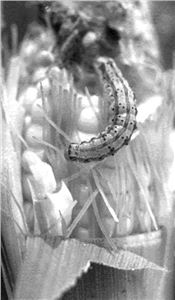
Corn earworm injury to corn ear.
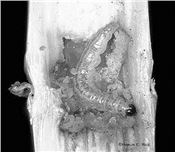
European corn borer larva
Photo courtesy of Marlin Rice, Iowa State University
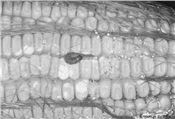
European corn borer injury to corn ear
Photo courtesy of Marlin Rice, Iowa State University
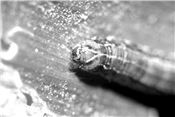
Fall armyworm larva.

Fall armyworm injury to ear.

Western bean cutworm
Photo courtesy of Marlin Rice, Iowa State University
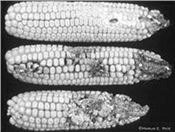
Western bean cutworm injury to corn ear
Photo courtesy of Marlin Rice, Iowa State University
|
|